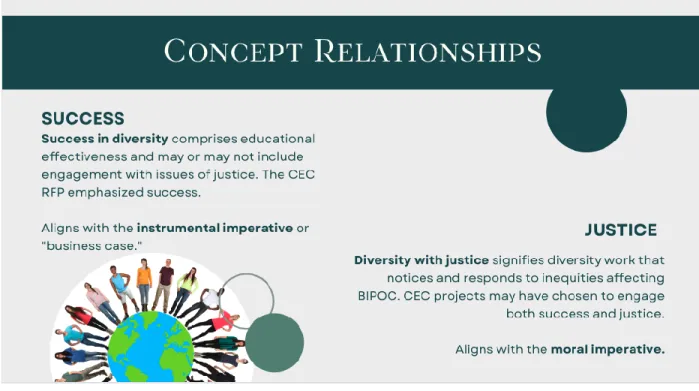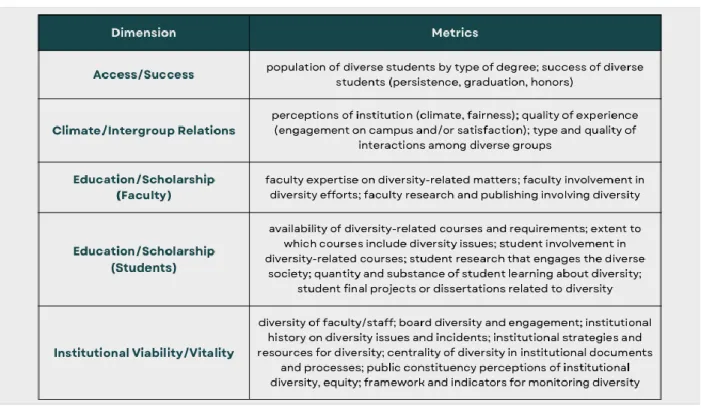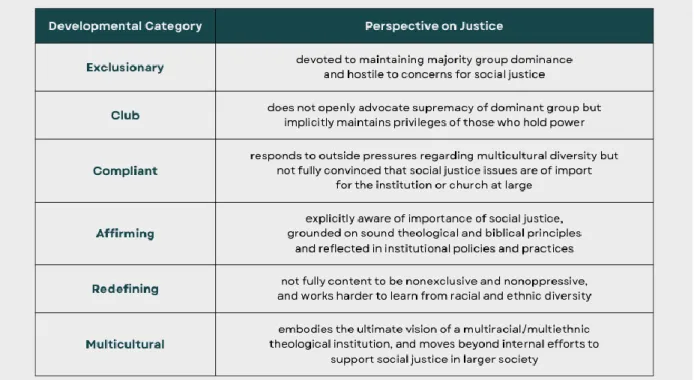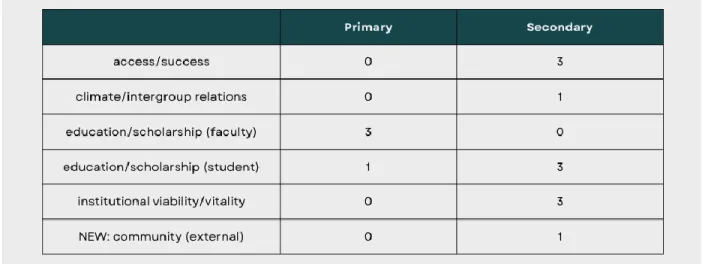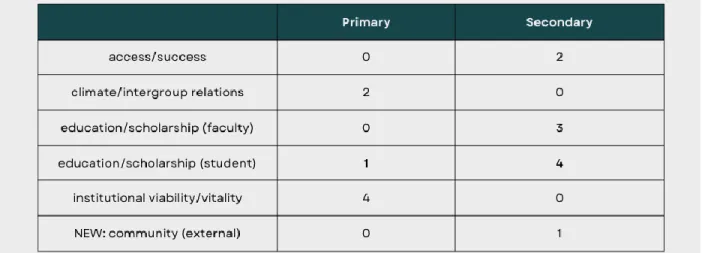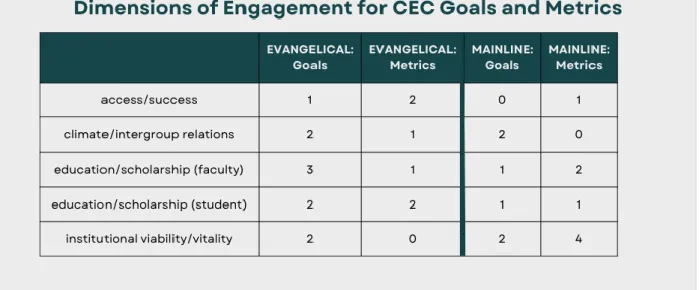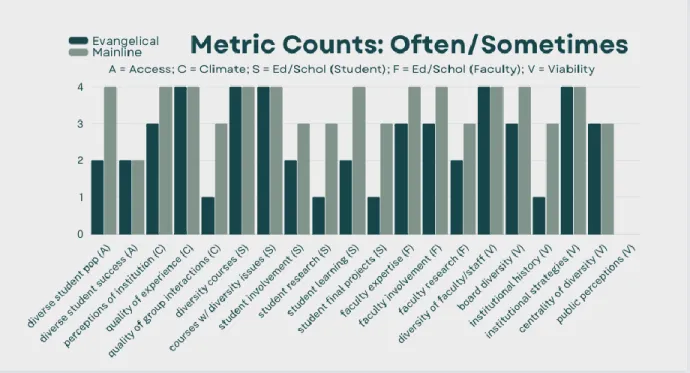Although the CEC initiative offers a path forward for ATS's diversity efforts, CEC's final reports offered limited results because ATS staff did not frame the initiative as an equity inquiry (J. Deasy et al., personal communication, June 23, 2021) ). Similarly, Davis, a global consultant across various industries, described a theoretical framework that prioritizes the moral imperative: belonging, dignity and justice (BDJ; 2021a, 2021b).5 The framework serves as an alternative to the traditional DEI framework.
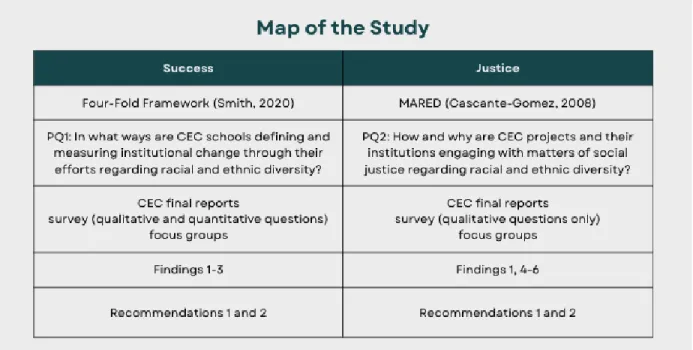
Smith’s Four-Fold Framework
To assess diversity success, this project adapted Smith's (2020) fourfold framework for institutional capacity for diversity. Smith's (2020) framework meets the first criterion that emerged from the literature review: the institution-wide level of analysis.
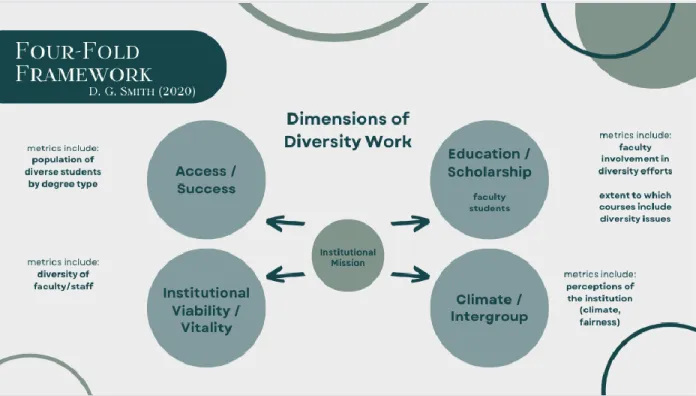
Cascante’s MARED
Secondary dimensions of focus for major schools included education/scholarship (student) for four schools, education/scholarship (faculty) for three schools, access/achievement for two schools, and community (external) for one school (see Table 4). The CEC projects at the remaining two major schools did not address social justice issues as significantly, if at all. For all indicators of access/achievement, mainline schools reported the highest mean scores (2.67) compared to evangelical schools (1.83), a difference of nearly 1.00 points.
For climate/intergroup relations markers (see Table 7), the most frequently measured marker was quality of experience (campus participation and/or satisfaction) as reported by major schools (2.50). Major schools reported the same measurement average of 2.0 for the two least frequently measured markers. For education/scholarship markers (student; see Table 8), the most frequently measured marker was the extent to which courses incorporate diversity issues as reported by majors (2.75).
For education/scholarship indicators (faculty; see Table 9), the most frequently measured indicator was faculty involvement in diversity efforts as reported by major schools (3.00). For indicators of institutional sustainability/vitality (see Table 10), the most frequently measured marker was faculty/staff diversity as reported by evangelical and mainstream schools (3.00). Three of the four participating high schools indicated that their school's official statements reflect social justice issues.
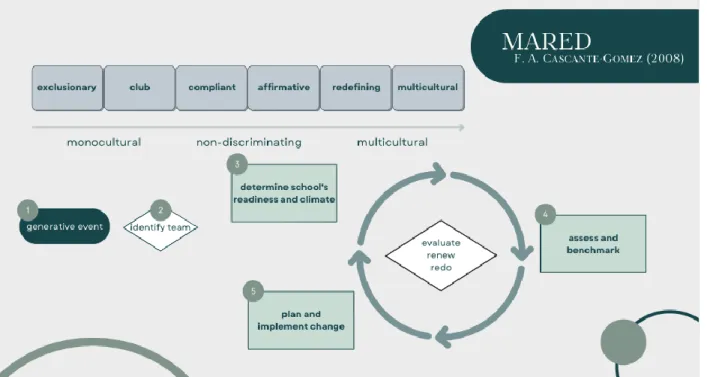
Head schools also cited additional challenges, including the potential limitations of their church identities. First, each church family included one or more schools with diverse student demographics that no longer contained a predominantly White student body, although they still identified as a PWTI. In addition, two of the major institutions described equity work as a growing benefit for their schools.
Furthermore, while I expected that the denominational traditions at mainstream schools would have produced more involvement in justice work than those at evangelical schools, the focus groups suggested that the opposite may be the case in at least some cases. None of the evangelical schools identified resistance to their justice efforts, and one evangelical school referred to denominational identity as a resource for justice work. Additionally, the three mainline schools affiliated with single denominations discussed the limitations of those identities for their justice work.
Furthermore, evangelical energies for justice work align with calls in Christian higher education for the engagement of evangelical institutions with justice issues (Lang & Yandell, 2019; Luna De La Rosa & Jun, 2019).
Additionally, through the focus groups, schools reported appreciation of efforts such as the CEC initiative that help them clarify and improve their diversity work and metrics. Two colleges expressed appreciation for the CEC initiative as a resource that helped create continued forward momentum in diversity efforts. We held ourselves accountable to what we said we were going to do, at least to some degree, and we talked about it publicly."
How do we get better at not just taking for granted that we are in the diverse environment, but making sure that it affects the students, it affects what we do, it affects how we operate as an institution, and that it things are what persist?". This need for clarity and support regarding diversity efforts illustrates the diverse meanings of and goals for diversity within organizations and the related challenge of measurement (Roberson, 2006).
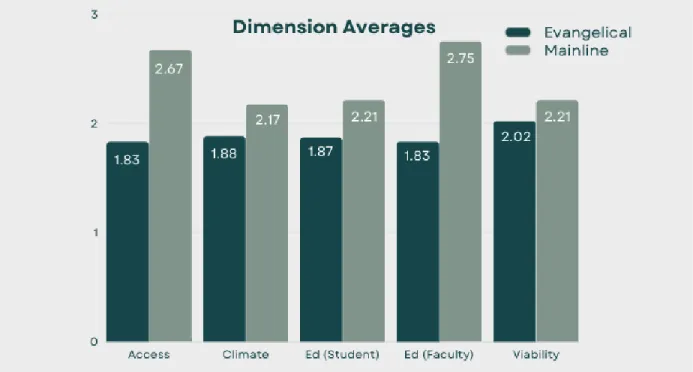
Using this study's definition of justice, when I coded the CEC reports, I noted which schools implicated justice as a primary focus of their CEC project: 0 of the 4 evangelical schools and 3 of the 5 mainline schools. Unfortunately, the open-ended survey questions and focus group protocol regarding social justice engagements did not shed as much light as I had hoped on the whys and hows of diversity work in the CEC schools. Schools did not share sufficient detail to determine their definitions of equity or rationale for self-reported equity-related activities.
For example, in surveys, when asked how their CEC projects or institutions engaged in social justice related to racial/ethnic diversity, most schools listed various activities rather than describing any particular definition or rationale. for justice. Because the main group had more participating schools than the evangelical group, the main group needed more time to answer each question. Therefore, I was not able to ask the main group as many questions as I did the evangelical group; to. the evangelical group answered all the same questions as the main group plus a few additional questions.
I could not identify precise definitions or rationales for fairness, at least due to lack of time and probably also due to lack of clarity in the schools themselves.
Within the dimension of climate/intergroup relations, evangelical schools engaged with justice by aiming for racial and ethnic conformity. In contrast, within the same dimension, majors engaged with justice by constructing resources for intergroup conflict, aiming for inclusion and equality for all, and easing the burdens of diversity work for BIPOC. Similarly, within the dimension of institutional viability/vitality, evangelical schools engaged with justice by raising awareness of diversity, constructing or editing institutional documents related to diversity, and consciously leaning into institutional diversity.
Conversely, within the same dimension, mainstream schools engaged with justice by aiming to become an anti-racist institution and responding to institutional racism. At least three of our strategic initiatives are currently linked in some form to DEI's work. This finding highlights a complementary point to that of Finding 1, in which I noted that sometimes mainstream CEC schools may not engage with justice as often or may have more resistance compared to mainstream schools. Evangelicals of the CEC.
This finding explains that on at least some of Smith's (2020) dimensions, mainstream schools are indeed engaging more intentionally or deeply with justice concerns, as the literature on the differences between evangelical and mainstream traditions often notes (Compton, 2020 ; Engebretson, 2022; Houston & Todd, 2013).
Second, for their CEC projects, although both church families engaged in various Smith (2020) dimensions, they did not necessarily align goals with metrics. Third, within their institutions more broadly, both church families engage in various Smithian dimensions and prioritize similar metrics, but they may not have consistent metric definitions. Mainline schools reported higher measurement averages across all Smith dimensions and metrics, but both church families reported at least measurement statistics for each Smith category.
Further, on average, CEC schools ranked the measurement frequency for metrics that encompass each individual Smith category at the same or very similar, indicating that both church families prioritized similar metrics for each category. Second, although both church families were engaging with justice in most or all of Smith's (2020) dimensions through their CEC activities and/or more broadly within their institutions, their definitions and/or rationale for justice remained unclear. Third, the two church families appeared to engage with justice to different depths on at least some Smith dimensions.
Fourth, both church families expressed similar struggles to mobilize for change regarding diversity and appreciated support such as the CEC initiative and the focus groups.
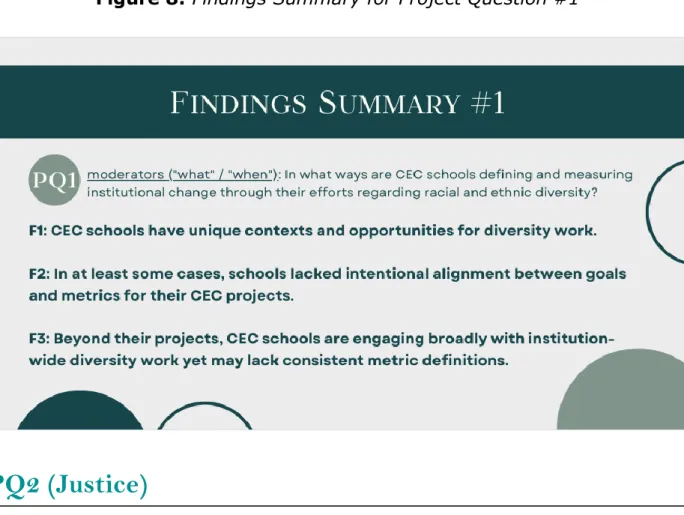
It concludes with an exemplary resource that ATS could use in its future diversity work with member schools, a resource that Rev. Amidst their unique contexts and opportunities for diversity work (Finding 1), these schools need clear definitions and rationales for their equity work. (Finding 4), encouragement to focus deeply on issues of justice (Finding 5), and support for mobilization for change (Finding 6). Although the new accreditation standards allow for a greater variety of definitions and approaches to diversity work (ATS J. Deasy & D. H. C. Gin, personal communication, June 9, 2021), ATS could complement this more general approach with frameworks and resources for schools that interested in using them.
In the focus groups, at least one evangelical school described the scarcity of funding, staffing, and capacity as limiting their efforts to pursue diversity work with equity. As the literature review shows, multiple frameworks exist to help schools assess and measure the success of their diversity work (Milem et al., 2005; Smith, 2020; Williams et al., 2005). Meanwhile, the Smith (2020) framework provides a reliable list of 21 metrics that institutions can use to measure their diversity work.
It concludes with an encouragement to envision a next step or two for their institution's diversity work.
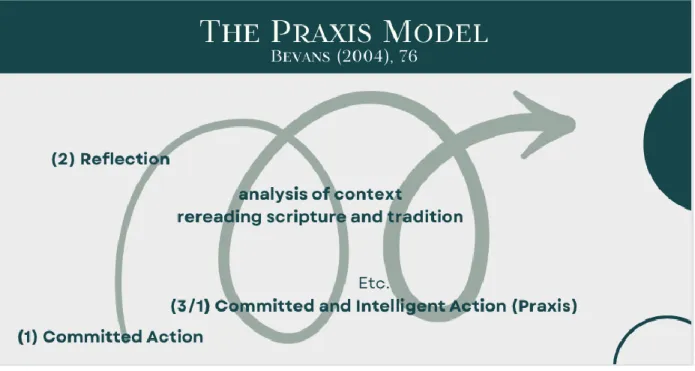
It can spark ways in which CEC and other ATS member schools could make meaningful connections between their diversity efforts, institutional climate (including perspectives on diversity), and student outcomes (Hurtado et al., 2008). A CDI impact study (Smith et al., 2006) addressed all four goals through six evaluation questions. These questions assessed (1) goals and strategies involving Irvine-funded efforts; (2) access/performance status of URM and low-income populations on CDI campuses; (3) the state of institutional capacity for diversity on CDI campuses in relation to climate/intergroup relations, education/scholarship, and institutional viability/vitality; (4) status of general institutional change; (5) the impact of foundation efforts on campus efforts; and (6) overall experience gained.
I highlighted the ATS values of diversity and equity, focusing on two possible imperatives for diversity work—the instrumental and the moral—and developing a two-part conceptual framework that tends toward both. Is a commitment to diversity and social justice clearly stated in the seminar's mission and values. How (if at all) have your CEC projects helped your schools think about social justice issues that include racial and ethnic diversity.
To what extent does your school measure these indicators for education and literacy that involve racial/ethnic diversity? Q25: How (if at all) has your CEC project engaged with issues of social justice involving racial/ethnic diversity. Q4: How (if at all) have your CEC projects helped your schools reflect on issues of social justice involving racial and ethnic diversity.
